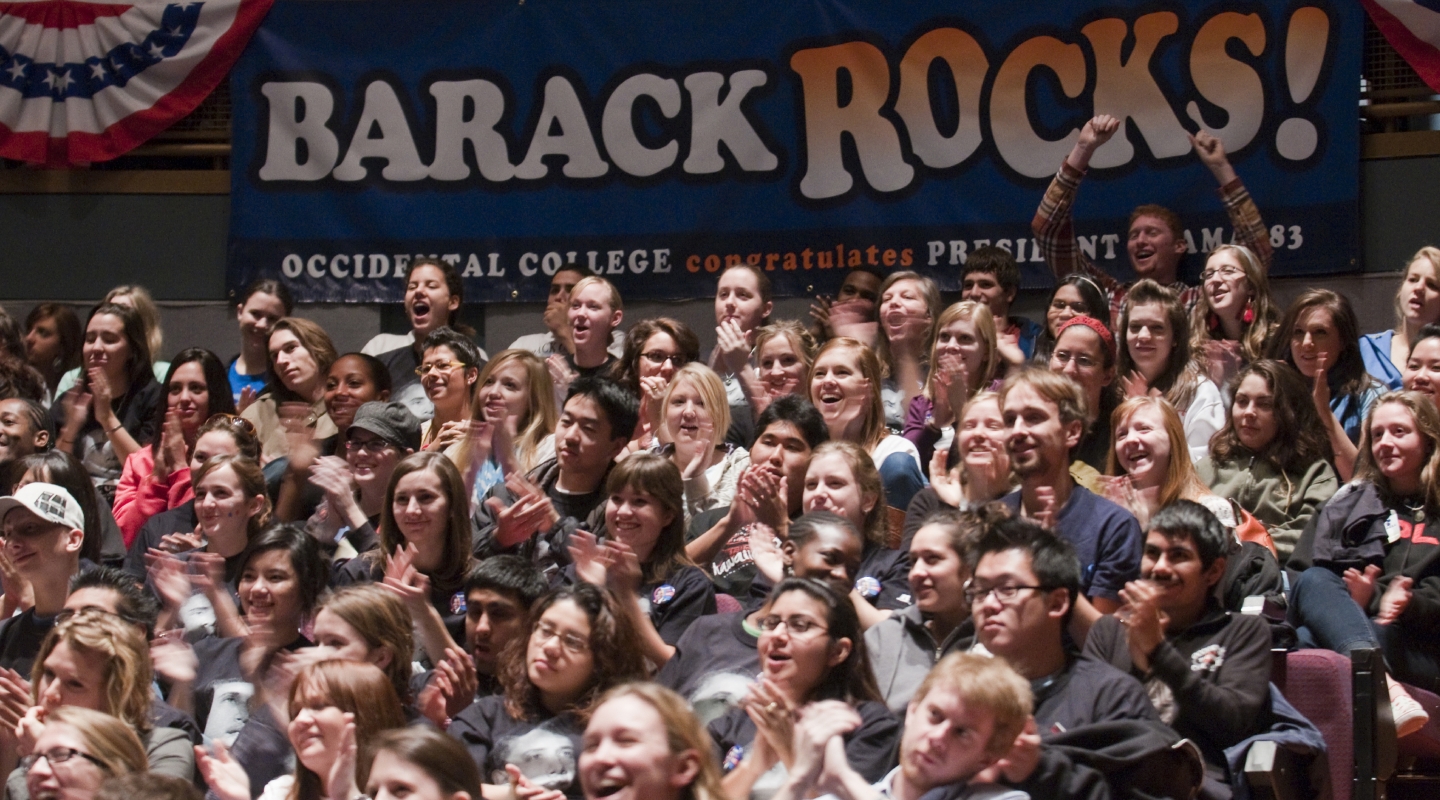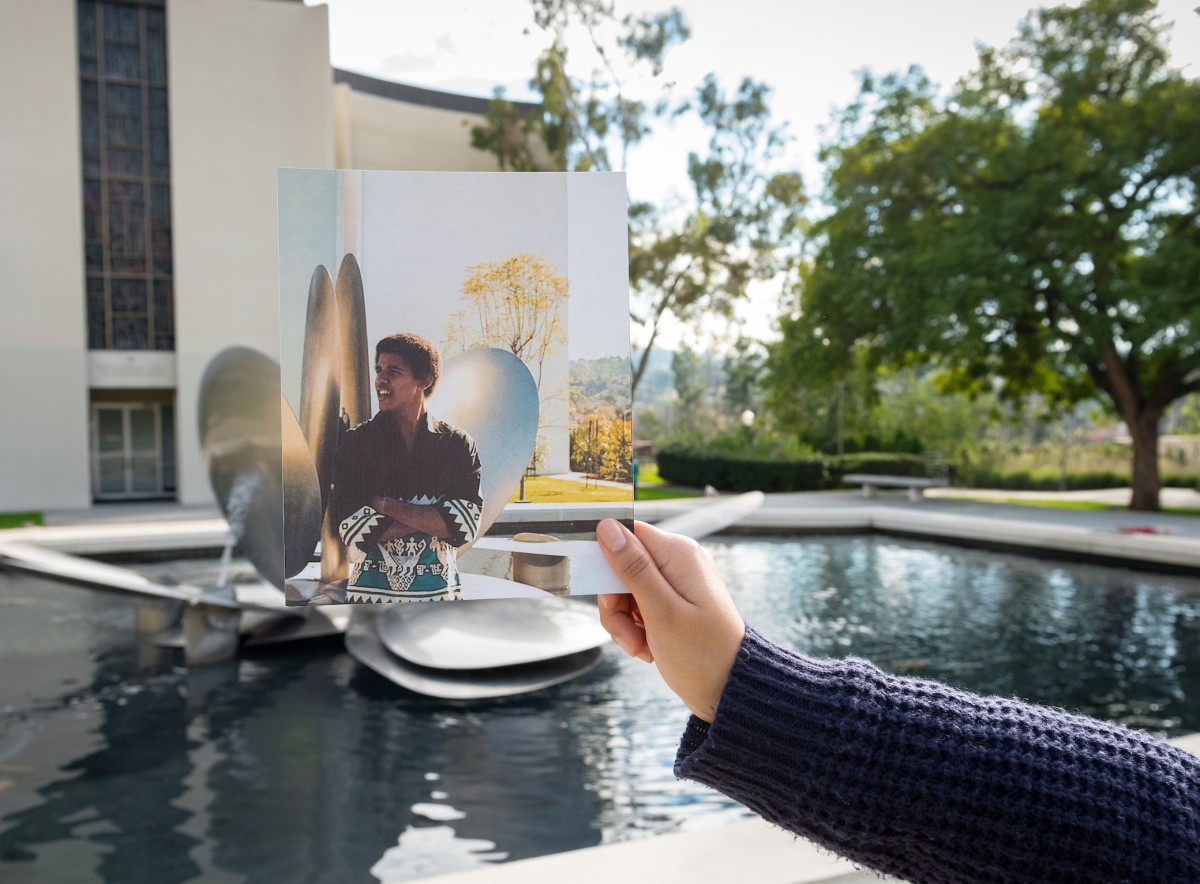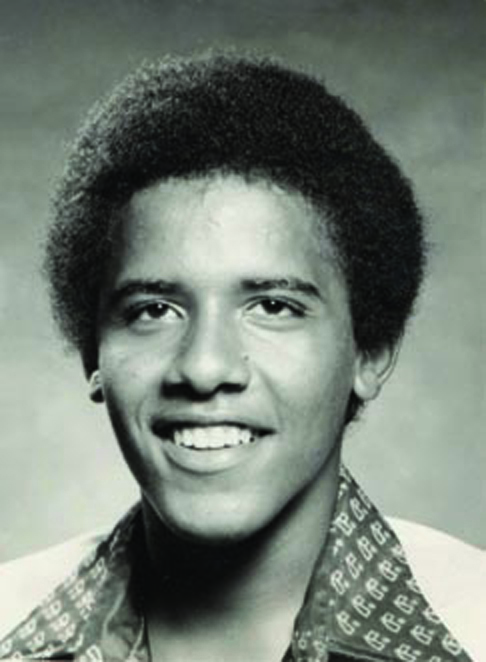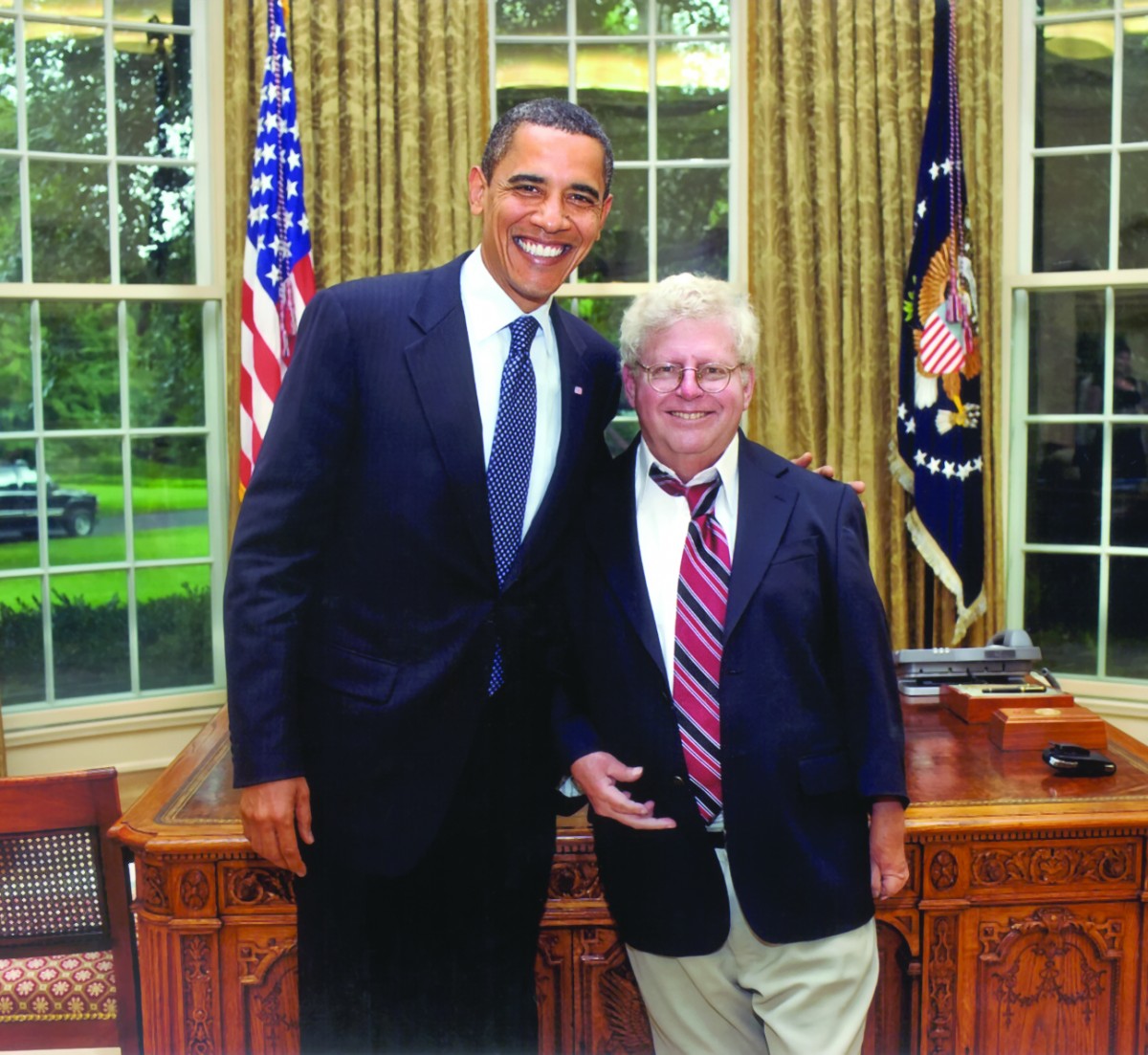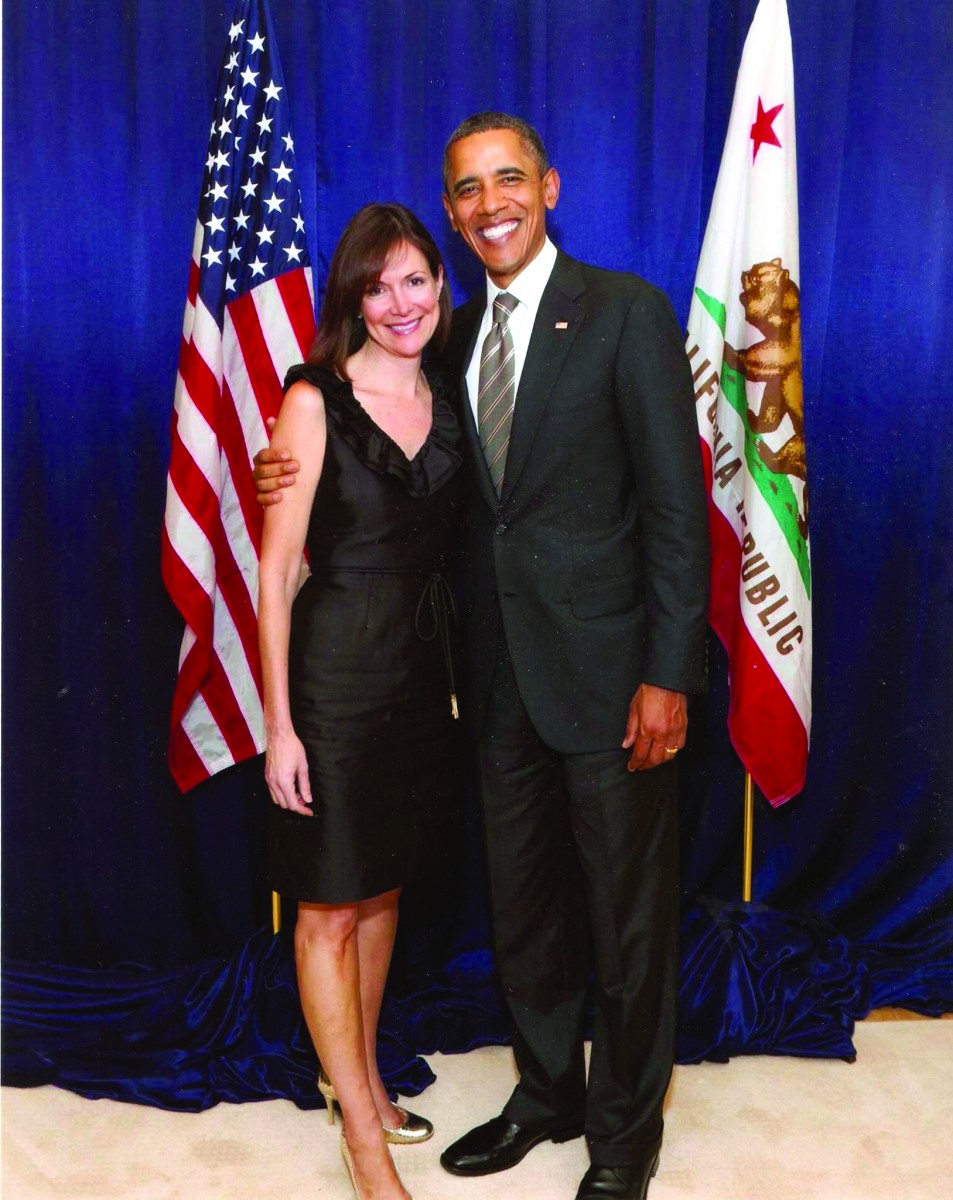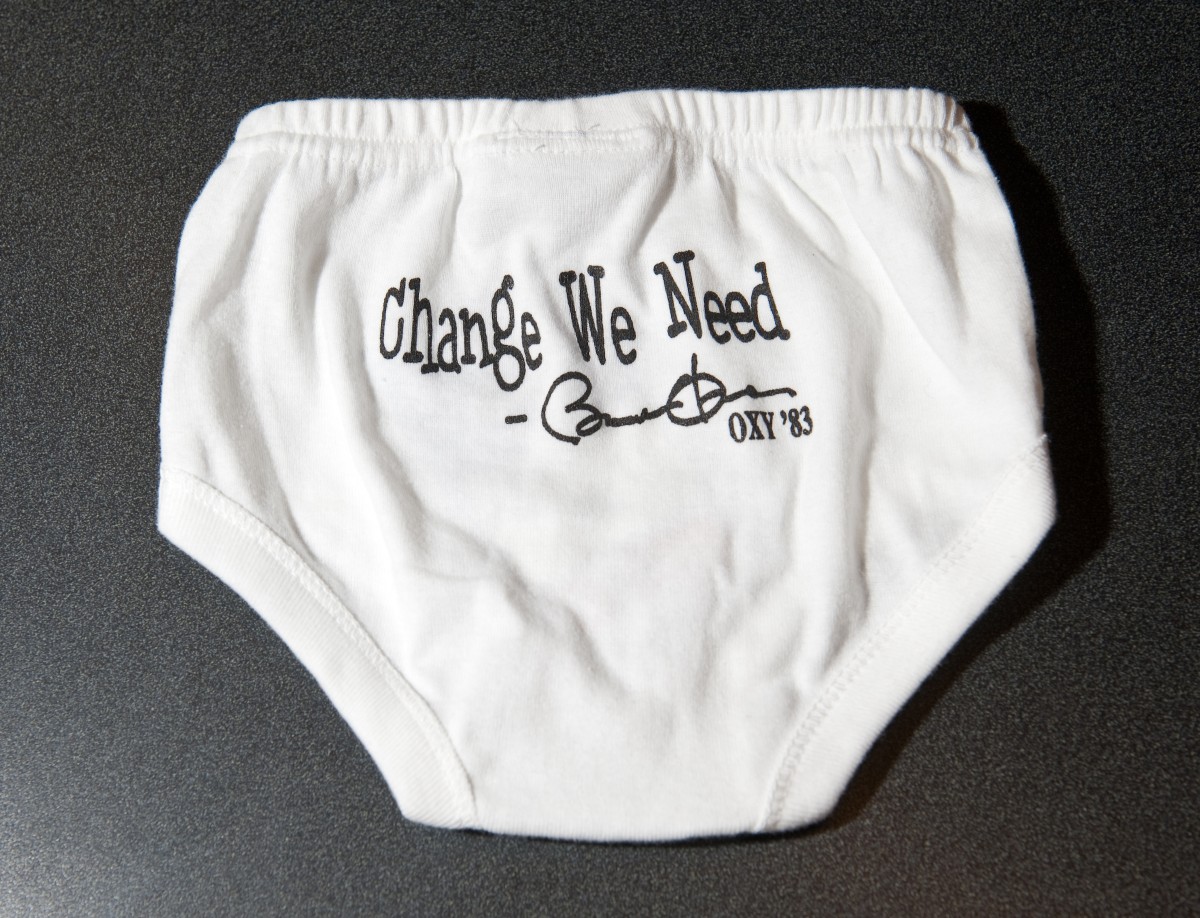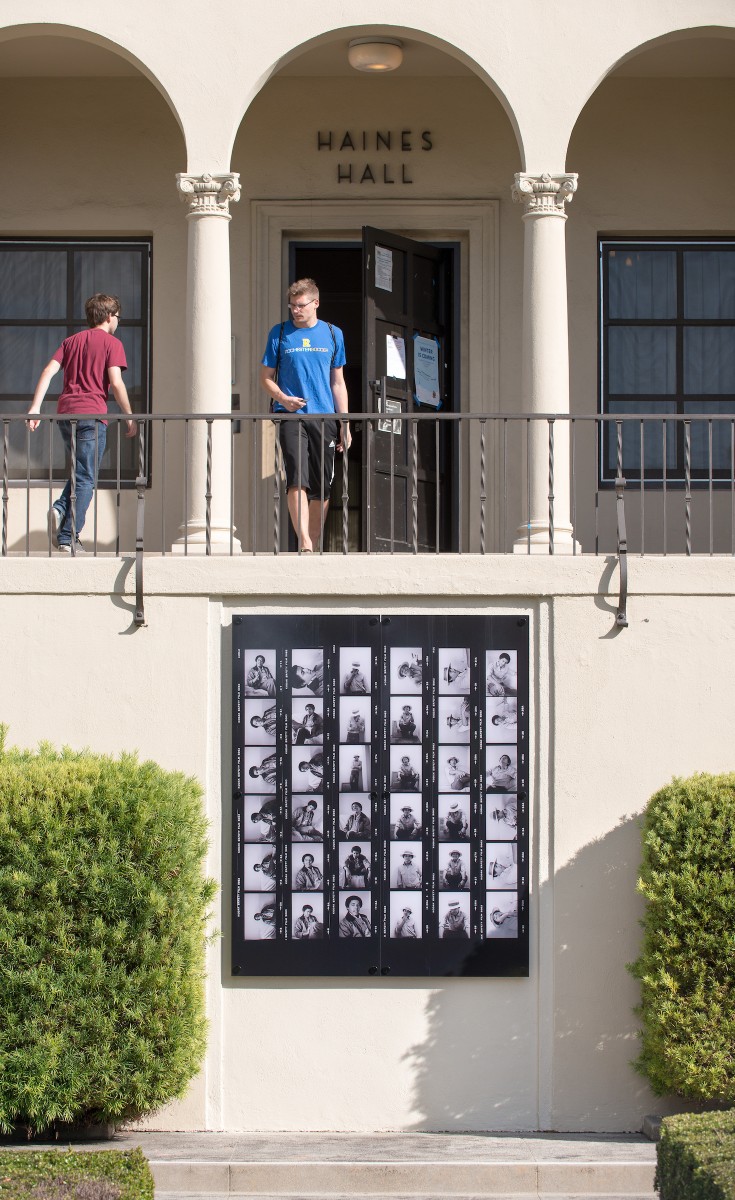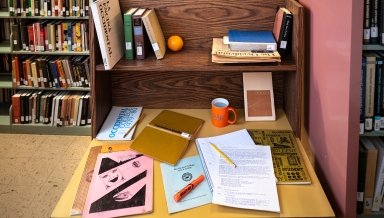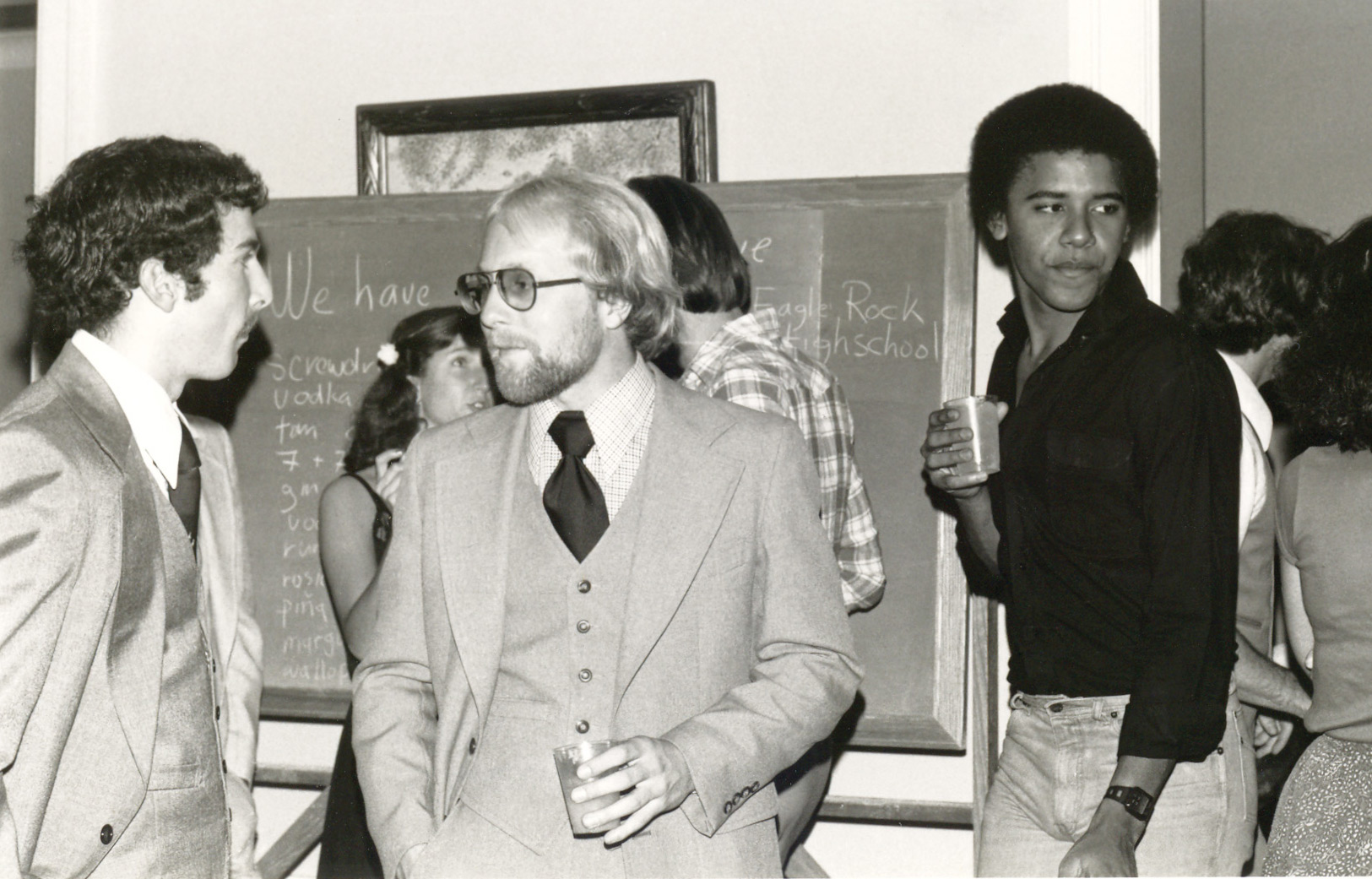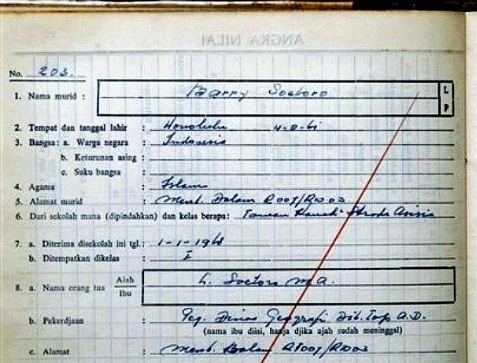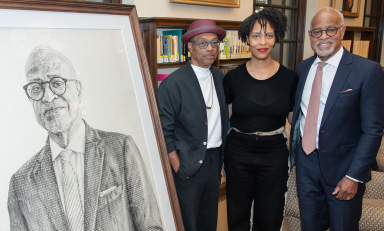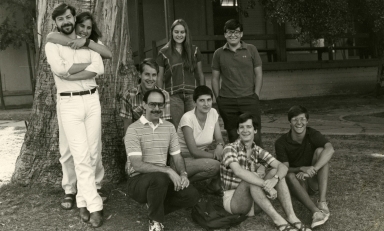Prior to 2008, Occidental was best known in many circles as an academic "hidden gem" (and as a popular film location). But the nation's 44th president put Oxy on the map—just as the College awakened Obama to his leadership potential.
By Andy Faught | Photo by Marc Campos
En route to a Pasadena jazz and art festival in 1980, the friends gathered at Oxy's Lucille Y. Gilman Memorial Fountain to carpool to their destination. With arms crossed over his buttoned-down Hawaiian shirt, Barry Obama '83 stood against the fountain's parabolic steel formations and gazed eastward. Finding inspiration in the moment was Eric Moore '83, who took up his Canon single- lens reflex camera and snapped a photo of his friend—an image that decades later would be reprinted in publications the world over.
"It was spontaneous, a candid moment—I think I was the only guy who had a camera," recalls Moore, a diplomacy and world affairs and economics double major and one of a small number of African American students enrolled at Occidental at the time.But Moore—an Oxy trustee and principal in the Los Angeles office of Avison Young, a global commercial real estate firm—claims another role in the evolution of the man who would be president. "I was the first person outside his family to only call him Barack," he says. "He always went by Barry, for simplicity and as an accommodation to Anglo society. I said I would only call him Barack, because it was a strong African name. I like to think that I helped him free his mind. I don't think we would have elected a man with a name that sounds like a soft fruit!"
As Obama's eight years in the White House came to an end in January, Occidental's influences are writ large on the president's development and legacy. But so is his impact on the College—in everything from a bump in admission applications to sales of Obama-related merchandise at the College bookstore. Oxy found itself at ground zero in the "birther" debate, with opponents challenging his U.S. citizenship—and more than once addressing the question "How can you call Obama an alumnus when he transferred to Columbia after two years?" To which we reply: Well, he is.
Obama's Oxy story begins in 1979, when the mixed-race son of a single mother enrolled at the College from Punahou School in Honolulu to be near his girlfriend. "I had graduated without mishap, was accepted into several respectable schools, and settled on Occidental College in Los Angeles mainly because I'd met a girl from Brentwood while she was vacationing in Hawai'i with her family," Obama wrote in his 1995 memoir Dreams From My Father. "But I was still just going through the motions, as indifferent toward college as toward most everything else."
Before his political awakening, Obama was a guy named Barry, serving coffee and busing tables at the Tiger Cooler. Raised in Hawai'i, but also having lived in Kansas and Indonesia, he felt at one with all of his classmates' backgrounds, but particularly with international students, friends say.
"Here you are in Los Angeles, even then such a vibrant city, and there's no way that you can exist as a student without also existing as a citizen of the larger city, which I suspect that Barack, who has ambition, curiosity, and a sense of his own role, did," says Patt Morrison '74, a Los Angeles Times columnist and former Occidental trustee.
"I think that was probably a very important factor for anybody like him, coming from a smaller place—Hawai'i—where everybody knew each other, and getting a sense of the role of the college in the community, that it doesn't exist as a thing apart," she adds. "President Obama had a broad vision, and Oxy may have helped to bring him some of that vision."
Writing in The New Yorker in 2012, Margot Mifflin '83 recalled witnessing Obama's first public speech outside the Arthur G. Coons Administrative Center on Feb. 18, 1981. "As the opening speaker at a rally protesting Occidental's investments in companies that were doing business in apartheid South Africa, he stood with one hand in his pocket, spoke in declarative spurts, and showed no sign of being the orator who would become President nearly 28 years later," she wrote. "Before he could say much, he was carried off by two students pretending to be oppressive Afrikaners. … Decades later, Obama would spur a new generation of students into political action, forging a connection between '60s radicals and media-savvy millennials. But in the winter of 1981, he was just testing his courage."
Following the anti-apartheid rallies on campus, he and Moore would typically retreat to Moore's Wiley Hall dorm roof and listen to the social justice-laden lyrics of Stevie Wonder's music and Bob Marley & the Wailers' 1979 Survival album, the latter a call for pan-African solidarity.
By Obama's own account, his political genesis took root in two political theory courses taught by Roger Boesche, the Arthur G. Coons Distinguished Professor of the History of Ideas. In 2010, Obama said at the White House that Boesche's classes "sparked my general interest in politics."
"During my first two years of college, perhaps because the values my mother had taught me—hard work, honesty, empathy—had resurfaced after a long hibernation; or perhaps because of the example of wonderful teachers and lasting friends, I began to notice a world beyond myself," Obama noted in a commencement speech at Wesleyan University in 2008. "By the time I graduated from college, I was possessed with a crazy idea—that I would work at a grassroots level to bring about change."
Listening to a radio broadcast of the speech, Boesche recalls, "It was really clear that he was transformed—not just by me, but by the environment of Oxy, the students, and the faculty. He went from a very bright, but not terribly serious student to a very bright and very serious person."
"What is striking to me is that when asked by any number of people about his formative educational experiences, the president cites his time at Occidental, particularly his political science classes with Roger Boesche," says President Jonathan Veitch. "It's clear that the liberal arts education he received proved to be essential equipment in dealing with many of the most controversial issues of our time. It's no accident that this kind of education matters so enormously at that level."
In a letter last year to Boesche, anticipating his mentor's pending retirement, Obama wrote: "Your classroom is where my interest in politics began. Posing questions that have challenged societies through the ages, your teaching and research remind us of the importance of constant inquiry and debate, lessons that are the core of our democracy, and that I've drawn on throughout my life, particularly in this Office. You helped instill passion for ideas, not only in me, but in the generations of students who found in your courses inspiration that would guide them forward."
After Obama announced his presidential candidacy in February 2007, among his earliest supporters was Denise Campbell Bauer '86, who raised a total of $4.3 million for the president's two election campaigns and was appointed by Obama as ambassador to Belgium in 2013. (Her stint ended in January.)"I decided to support Sen. Obama because I believed that his vision for our country's future, combined with his intellect and integrity, would make him an outstanding president," Bauer says. "He did not let me down. I am proud of all that he accomplished, and grateful that I had the opportunity to play a small role."
Prior to 2008, Occidental was arguably best known to many outsiders for two pop culture touchstones from the 1990s: Beverly Hills 90210 and Clueless. Obama's election changed that, and the excitement on campus was palpable.
"This was Oxy's first 'go' as president. We thought Jack Kemp (the 1957 Oxy graduate who ran for president in 1988 and as the Republican vice presidential nominee eight years later) had a chance, but he didn't get there, so when Barack Obama was running there was widespread pride," says Larry Caldwell, the Cecil H. and Louise Gamble Professor in Politics Emeritus. "Everywhere I went, people were saying, 'This is amazing, it's good for the College.' There was a consensus even among Oxy Republicans that this was a good thing, to have a dynamic young president elected from our small college."
Oxy clearly has benefitted from its ties to Obama. From 2007 to 2009, applications to the College jumped nearly 14 percent, and the entering first-year class in the fall of 2009—578 students—remains the largest in College history. But that was due in part to Occidental admitting a larger number of students to offset projected admission decreases due to the recession, according to Vince Cuseo, vice president of enrollment and dean of admission.
Even so, the Obama connection "did generate an amplified institutional pride for the Oxy community," Cuseo says, "with the attendant benefit of influencing admitted students' lived experience when they were making their college decision. And I can confidently say it raised Oxy's visibility in the African American community, and gave us a stake in international markets."
Derek Shearer, the Stuart Chevalier Professor of Diplomacy and World Affairs and director of the McKinnon Center for Global Affairs, seized on the Obama presidency as a learning opportunity for students. He has taught (or co-taught with Caroline Heldman, associate professor of politics) three courses on the Obama presidency, one a senior seminar called Obama Foreign Policy.
In the latter, two of his students—a Democrat and a Republican—met to "figure out what to do about Afghanistan and Iraq" after the Bush presidency. "They ended up having a diplomacy session over whiskey—they called it the Whiskey Summit—where they sat down and figured out a position that they both could live with," says Shearer, the former ambassador to Finland under President Clinton. "It was really fun for the students. I was pressuring them to be practical."
Shearer also had a hand in developing a line of merchandise—dubbed BarOxyWear—for the Oxy bookstore, with fashion choices including "Barack Rocks" T-shirts, and a garment emblazoned with "1600 Campus Road to 1600 Pennsylvania Avenue" (with a photo of White House and Thorne Hall pillars to drive home the point).
Another popular item, a diaper cover, was adorned with words playing on Obama's campaign message: "Change We Need," with a replica Obama autograph on the tush. Following a story on NPR's "Morning Edition" (by producer Ben Bergman '04) and a page-one feature in The Wall Street Journal, the bookstore received 25 orders the next day. Other presidential sundries include mugs, hats, keychains, and pens."We met with vendors before the election and chose graphics to put on merchandise in anticipation of Obama's win," says bookstore manager Donna Huebner. "They were ready to be produced the second it was announced he would be our next president."
Local vendors drove finished T-shirts and sweatshirts to the bookstore to avoid shipping delays. Items were available within days of the election. The bookstore even carved out space to sell books that Obama read in his introductory political science courses, including Herbert Marcuse's One-Dimensional Man (1964) and The Wretched of the Earth (1961) by Frantz Fanon.
The bookstore sold the bulk of its items between November 2008 and Obama's first year in office, but Huebner notes that she got a T-shirt order in early January. All totaled, BarOxyWear has netted the College more than $39,400 in sales.
Even before Obama left the White House, efforts were already underway to commemorate his two years in Southern California. In December, California state Sen. Anthony Portantino introduced a resolution that would name the stretch of the 134 freeway between the 2 and the 210 the "President Barack H. Obama Freeway." Days earlier, a marker was placed outside the Pasadena apartment (at 253 E. Glenarm Street) where he lived as a sophomore—the brainchild of Pasadena City Councilman Steve Madison.
Already there's a memorial outside of Haines Hall, his freshman residence, in the form of an oversized contact sheet by Lisa Jack '81, whose student photos of Obama were first published in Time in 2008. In addition, Shearer is speaking with architect Hagy Belzberg about creating a monument located on the steps leading up to the Coons Administrative Center, where Obama made his first political speech. He also asked his study-abroad students to bring back to Eagle Rock Obama memorabilia from around the world. Oxy's Special Collections has exhibited many of those items as well as others donated to or purchased by the College, and Shearer plans to install a permanent showcase inside the McKinnon Center.
On a larger scale, President Veitch has been in conversation with senior advisers close to Obama about how to perpetuate the president's Oxy legacy. "Both Barack Obama and Jack Kemp were profoundly shaped by books and ideas, the taste for which they first acquired at Occidental," he says, adding that the College is amplifying its efforts to recognize Kemp's contributions as well.
Meanwhile, Eric Moore—the guy with the camera—is looking forward to reconnecting with Obama over a round of golf soon. The two last visited in 2014 in the Oval Office, catching up behind closed doors for 45 minutes while Moore's then-3-year-old son was running around and eating fruit from the presidential bowl. "I was worried he was going to break something," he says. And his old friend, the president? "I expect to see him again when he's got the time." At his 35th reunion next year, maybe?
Andy Faught wrote "Triumph of the Shrill" in the Fall 2016 magazine.
Obama on Oxy
At a ceremony nominating Jeh Johnson as secretary of Homeland Security on Oct. 18, 2013, President Obama noted, "Your wife, Susan, and your daughter, Natalie, couldn't be here because they're visiting Jeh Jr. out at Occidental College, which, by the way, I went to for two years when I was young. It's a fine college. I'm sorry I couldn't be there to say hi to him. But your son chose well."
"I became more socially conscious at Occidental even though I was partying—anti-Apartheid movement, starting to be interested in social policy and poverty and starting to study civil rights even if through the haze of a hangover," Obama admitted to former senior adviser David Axelrod in a podcast interview in December. "That [started] giving me a sense of what a purposeful life might look like."
In a Feb. 6, 2015, speech in Indianapolis, Obama noted that prospective college students were looking for "fancy gyms and gourmet food and really spiffy dorms." While he was at Oxy, he added, "There was something on the menu that we called roast beast, because we couldn't really tell what kind of meat it was."
Going back to the campaign trail in 2008, at a fundraiser in San Francisco, Obama noted that his first roommate at Oxy was Pakistani. And in Haines Hall, he added with a laugh, "Indians and Pakistanis came together under one roof … to cause havoc in the university. … Those are friendships which have lasted me for years, and continue to this day."
Alternative Facts
On April 1, 2009, a fake news story attributed to the Associated Press circulated that claimed that Barack Obama, under the name Barry Soetoro, received financial aid as a foreign student from Indonesia.
Although discredited, Obama detractors—including a certain future president and leader of the "birther" movement—continued to demand that America's 44th president release his birth certificate and that Occidental open his transcripts to scrutiny. (College transcripts do not detail financial aid sources.) The 1974 Family Educational Rights and Privacy Act, or FERPA, guarantees that school transcripts remain private.
Obama's transcripts "have been under lock and key for the last eight years, and will probably remain there," says Jim Tranquada, Occidental's director of communications. "At one point there was a reward being offered for someone to leak the president's transcripts." (A bogus transcript, above, has been circulating online since at least 2011.)
"Social media provides a medium where this kind of information, or misinformation, can go viral," he adds. "Because of social media's tendency to segregate audiences according to their own interests, you end up with this echo chamber. The fake AP story is still circulating today. I'm still seeing people post it on Facebook or Tweet it out."

